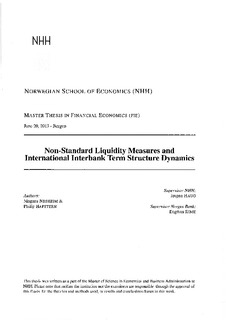| dc.description.abstract | Throughout the financial crisis central banks experienced a situation where standard monetary measures
failed to create stability and restore growth to the financial markets and the overall economy. Therefore
new response methods where introduced. One of the key responses was to extend longer maturity loans
through auctions supported by a wider range of collateral (The Term Auction Facility or TAF program).
In the aftermath of the crisis in financial markets the effect of this monetary measure has been widely
discussed. A key topic of interest is how it affected the term structure of interbank interest rates and
whether it restored access to liquidity for financial institutions.
In this thesis we develop and apply three statistical tests to study if the TAF had the intended effect on
US interbank rates, and whether or not spillover effects to other markets have been seen as well. First
we compute the frequency of a directional move following term auctions, and compare this with the
frequency in the overall financial crisis. Then we compute the expected size in such a move following
auction dates, and compare expected sizes in such moves during the rest of the financial crisis. Third
we use an event study to look for abnormal movements following auction dates. Here we estimate an
affine term structure model driven by a vector autoregressive model with the credit premium, liquidity
premium and short rate as driving factors in an affine term structure model.
The thesis has four major findings;
First, we find that the probability of drops in interbank interest rates and spreads tended to be more likely
and larger in size following the notification of information regarding the results of TAF-auctions.
Second, the Term Auction Facility caused international spillover effects which varied from market to
market. Specifically we found that unsecured loans with more than 5 months to maturity became less
expensive compared to unsecured loans with less than 5 months to maturity. These results were found
in the UK and EU, and were highly significant. The same results indicate that interest rate levels tended
to fall, but these results were not significant.
Third, interest rates on loans with more than 4 months to maturity dropped more than what could be
expected, even when credit and liquidity factors could be perfectly predicted. This suggests that the
results from TAF-auctions went a long way in reducing premiums on unsecured loans in the interbank
marked with longer maturities (5-12 months).
Last, the Term Auction Facility seem to have pulled down premiums on credit and liquidity beyond what
could be expected following the notification of results from the TAF auctions. These effects were seen
to spill over to the settlement day as well. | no_NO |
